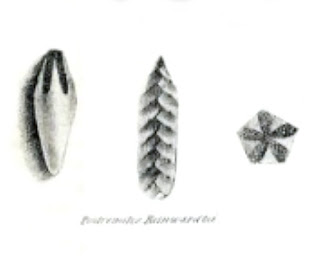 |
Macroporaster nylanderi drawing by Dr. Elvira Wood 1921
|
A Silurian Period fossil called
Macroporaster nylanderi (Raymond, 1921). It was found in sandstone at New Sweden, Aroostook County, Maine, USA by
Olof O. Nylander who the species is named after. Outer radius is 19 mm and inner radius is 7 mm, depth 2-2.5 mm. It was described in
No.4 - A New Fossil Starfish From New England by Percy E. Raymond published Proceedings Boston Society of Natural History Volume 36 (August 1921). When fossil was published it was shown to be specimen number 14,966 in collection of Boston Society of Natural History.
Above is figure 7 in article drawn by Dr. Elvira Wood. This image was one of many illustrations she did for Dr. Raymond's publications between 1920-1924. Dr. Wood published one of the first American drawings of a starfish in 1909 of Troost's Palaeaster antiqua (Troost, 1835). Charles Schuchert renamed that fossil Mesopalaeaster antiquus (Troost, 1835) in 1915.
The current fossil is stored at the National Museum of Natural History at the Smithsonian Institution in Washington, D.C. and is listed as a holotype USNM PAL 166743. Another picture of this specimen shows its label (maybe from Boston) showing it was purchased from Nylander. Olof O. Nylander (1864-1943) was born in Oremella, Sweden where he became interested in natural history. He migrated to the United States in 1883 and worked in various states as a painter. He later was contracted out as a geologist for the U.S. Geological Survey, the Canadian government, and various universities/colleges. In 1939, the WPA built the Nylander Museum of Natural History in which he was the first curator-director. It housed his collections which were transferred to them in 1943 at his death. As of this writing, the museum in closed to the public.
Judging from the Smithsonian picture compared to the drawing, someone tried to prep this fossil and destroyed part of it. The paper described it as not having any other fossils on the matrix but it looks like the area around the fossil was removed and a small brachiopod fossil (reminds me of a Rhynchotreta) was revealed.































